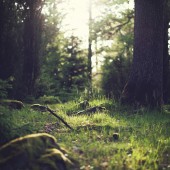There are three main types of mountains: volcanic, fold, and block. All three types are formed from plate tectonics: when portions of the Earth’s crust move, crumple, and dive. Compressional forces, isostatic uplift and intrusion of igneous matter forces surface rock upward, creating a landform higher than the surrounding features. The height of the feature makes it either a hill or, if higher and steeper, a mountain. Major mountains tend to occur in long linear arcs, indicating tectonic plate boundaries and activity.
Volcanoes
Volcanoes are formed when a plate is pushed below another plate, or at a mid-ocean ridge or hotspot. At a depth of around 100 km, melting occurs in rock above the slab (due to the addition of water), and forms magma that reaches the surface. When the magma reaches the surface, it often builds a volcanic mountain, such as a shield volcano or a stratovolcano. Examples of volcanoes include Mount Fuji in Japan and Mount Pinatubo in the Philippines. The magma does not have to reach the surface in order to create a mountain: magma that solidifies below ground can still form dome mountains, such as Navajo Mountain in the United States.
Fold mountains
Fold mountains occur when two plates collide: shortening occurs along thrust faults and the crust is overthickened. Since the less dense continental crust “floats” on the denser mantle rocks beneath, the weight of any crustal material forced upward to form hills, plateaus or mountains must be balanced by the buoyancy force of a much greater volume forced downward into the mantle. Thus the continental crust is normally much thicker under mountains, compared to lower lying areas. Rock can fold either symmetrically or asymmetrically. The upfolds are anticlines and the downfolds are synclines: in asymmetric folding there may also be recumbent and overturned folds. The Jura Mountains are an example of fold mountains.
Block mountains
Block mountains are caused by faults in the crust: a seam where rocks can move past each other. When rocks on one side of a fault rise relative to the other, it can form a mountain. The uplifted blocks are block mountains or horsts. The intervening dropped blocks are termed graben: these can be small or form extensive rift valley systems. This form of landscape can be seen in East Africa, the Vosges, the Basin and Range province of Western North America and the Rhine valley. These areas often occur when the regional stress is extensional and the crust is thinned.
Erosion
During and following uplift, mountains are subjected to the agents of erosion (water, wind, ice and gravity) which gradually wear the uplifted area down. Erosion causes the surface of mountains to be younger than the rocks that form the mountains themselves. Glacial processes produce characteristic landforms, such as pyramidal peaks, knife-edge arêtes, and bowl-shaped cirques that can contain lakes. Plateau mountains, such as the Catskills, are formed from the erosion of an uplifted plateau.
Source: Wikipedia page “Mountain”, “Geology” section.

This photo was taken from unsplash, by Sylwia Bartyzel.